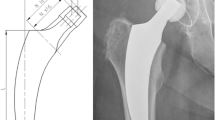Abstract
Introduction
Short-stem prostheses enable bone stock preserving total hip arthroplasty. However, little is known about the durability of this group of implants. The most common cause for implant failure is aseptic loosening. Early implant migration is supposed to be the best indicator for mechanical failure of femoral stems. The purpose of this study was to evaluate the migration pattern of a short stem implant and the influence of BMI, gender and femoral offset on implant migration.
Materials and methods
After a minimum follow-up of 2 years, 72 hips were included in this EBRA-FCA-study. The mean age at surgery of the 34 female and 32 male patients was 54 years (range 22–75 years). The mean BMI was 29 kg/m2 (range 21–51 kg/m2).
Results
Mean axial subsidence was 1 mm (±1.4 mm) after 24 months. BMI, gender and implant offset did not influence implant migration on a statistical significant level. Nevertheless, a tendency towards more migration in obese and female patients was observed.
Conclusion
The evaluated short stem prosthesis showed a migration pattern similar to clinical proven standard straight stem implants. The indication of short-stem prostheses should be critically evaluated in obese and female patients.



Similar content being viewed by others
References
Learmonth ID, Young C, Rorabeck C (2007) The operation of the century: total hip replacement. Lancet 370(9597):1508–1519
Kärrholm J, Garellick G, Rogmark C, Rolfson O, Herberts P (2012) Swedish HIP Arthroplasty Register: annual report 2011. Sahlgrenska University Hospital, Sahlgrenska
Coulter G, Young DA, Dalziel RE, Shimmin AJ (2012) Birmingham hip resurfacing at a mean of ten years: results from an independent centre. J Bone Jt Surg Br 94(3):315–321
Powers-Freeling L (2012) National Joint Registry for England and Wales. 9th annual report 2012. Available from: http://www.njrcentre.org.uk/NjrCentre/Portals/0/Documents/England/Reports/9th_annual_report/NJR. 9th Annual Report 2012.pdf
Johanson PE, Fenstad AM, Furnes O, Garellick G, Havelin LI, Overgaard S et al ((2010)) Inferior outcome after hip resurfacing arthroplasty than after conventional arthroplasty. Evidence from the Nordic Arthroplasty Register Association (NARA) database, 1995 to 2007. Acta Orthop 81(5):535–541
AQUA (2012) Hüftendoprothesenversorgung. Göttingen: AQUA—Institut für angewandte Qualitätsförderung und Forschung im Gesundheitswesen GmbH
Khanuja HS, Vakil JJ, Goddard MS, Mont MA (2011) Cementless femoral fixation in total hip arthroplasty. J Bone Jt Surg Am 93(5):500–509
Bieger R, Ignatius A, Decking R, Claes L, Reichel H, Durselen L ((2012)) Primary stability and strain distribution of cementless hip stems as a function of implant design. Clin Biomech (Bristol, Avon) 27(2):158–164
Krismer M, Biedermann R, Stockl B, Fischer M, Bauer R, Haid C (1999) The prediction of failure of the stem in THR by measurement of early migration using EBRA-FCA. Einzel-Bild-Roentgen-analyse-femoral component analysis. J Bone Jt Surg Br 81(2):273–280
Bieger R, Ignatius A, Reichel H, Durselen L (2013) Biomechanics of a short stem: in vitro primary stability and stress shielding of a conservative cementless hip stem. J Orthop Res 31(8):1180–1186
Karrholm J (2012) Radiostereometric analysis of early implant migration—a valuable tool to ensure proper introduction of new implants. Acta Orthop 83(6):551–552
Karrholm J, Herberts P, Hultmark P, Malchau H, Nivbrant B, Thanner J (1997) Radiostereometry of hip prostheses. Review of methodology and clinical results. Clin Orthop Relat Res 344:94–110
Biedermann R, Krismer M, Stockl B, Mayrhofer P, Ornstein E, Franzen H (1999) Accuracy of EBRA-FCA in the measurement of migration of femoral components of total hip replacement. Einzel-Bild-Rontgen-analyse-femoral component analysis. J Bone Jt Surg Br 81(2):266–272
Wilkinson JM, Hamer AJ, Elson RA, Stockley I, Eastell R (2002) Precision of EBRA-digital software for monitoring implant migration after total hip arthroplasty. J Arthroplast 17(7):910–916
Lazarinis S, Mattsson P, Milbrink J, Mallmin H, Hailer NP (2013) A prospective cohort study on the short collum femoris-preserving (CFP) stem using RSA and DXA: primary stability but no prevention of proximal bone loss in 27 patients followed for 2 years. Acta Orthop 84(1):32–39
Schmidutz F, Graf T, Mazoochian F, Fottner A, Bauer-Melnyk A, Jansson V (2012) Migration analysis of a metaphyseal anchored short-stem hip prosthesis. Acta Orthop 83(4):360–365
Floerkemeier T, Tscheuschner N, Calliess T, Ezechieli M, Floerkemeier S, Budde S et al (2012) Cementless short stem hip arthroplasty METHA(R) as an encouraging option in adults with osteonecrosis of the femoral head. Arch Orthop Trauma Surg 132(8):1125–1131
Ruben RB, Fernandes PR, Folgado J (2012) On the optimal shape of hip implants. J Biomech 45(2):239–246
Bauer R, Kerschbaumer F, Poisel S, Oberthaler W (1979) The transgluteal approach to the hip joint. Arch Orthop Trauma Surg 95(1–2):47–49
Morrey BF, Adams RA, Kessler M (2000) A conservative femoral replacement for total hip arthroplasty. A prospective study. J Bone Jt Surg Br 82(7):952–958
Gustke K ((2012)) Short stems for total hip arthroplasty: Initial experience with the Fitmore stem. J Bone Jt Surg Br 94-B(11 Suppl):47–51
Wolf O, Mattsson P, Milbrink J, Larsson S, Mallmin H (2010) Periprosthetic bone mineral density and fixation of the uncemented CLS stem related to different weight bearing regimes: a randomized study using DXA and RSA in 38 patients followed for 5 years. Acta Orthop 81(3):286–291
Jacobs CA, Christensen CP (2009) Progressive subsidence of a tapered, proximally coated femoral stem in total hip arthroplasty. Int Orthop 33(4):917–922
Patel RM, Smith MC, Woodward CC, Stulberg SD (2012) Stable fixation of short-stem femoral implants in patients 70 years and older. Clin Orthop Relat Res 470(2):442–449
Rohrl SM, Li MG, Pedersen E, Ullmark G, Nivbrant B (2006) Migration pattern of a short femoral neck preserving stem. Clin Orthop Relat Res 448:73–78
Acknowledgments
The authors thank Semra Kocak for the statistical analysis.
Conflict of interest
None.
Author information
Authors and Affiliations
Corresponding author
Rights and permissions
About this article
Cite this article
Freitag, T., Kappe, T., Fuchs, M. et al. Migration pattern of a femoral short-stem prosthesis: a 2-year EBRA-FCA-study. Arch Orthop Trauma Surg 134, 1003–1008 (2014). https://doi.org/10.1007/s00402-014-1984-x
Received:
Published:
Issue Date:
DOI: https://doi.org/10.1007/s00402-014-1984-x




